Tag Archive: language intervention
March 26, 2015
by Carole Zangari -

Many of us have worked with learners who have a special interest in trains, but even kids who don’t give trains more than a passing glance still generally love the Toca Train app by Toca Boca. In this post, we welcome back SLPs Nerissa Hall and Hillary Jellison of Communicare, LLC who share how they use Toca Train in their clinical work with young AAC learners. In addition to their prAACtical suggestions, they generously share a train-themed communication board and their data sheet for the phrases that can be targeted in this activity. iPad applications are fun and engaging, and can be a great addition to any clinician’s intervention toolkit. We use iPad applications to engage our learners in play-based activities that address a range of speech, language, and communication goals. One of our learners’ favorite applications is Toca Train; a bright and colorful application that involves a train moving around a track at different speeds, controlled... [Read More...]
Filed under: PrAACtical Thinking
Tagged With: Hillary Jellison, language intervention, Nerissa Hall
July 30, 2014
by Carole Zangari -
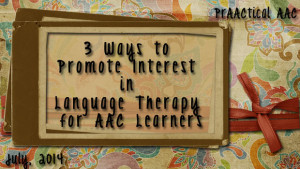
In an earlier post, we raised this question: Why work hard at something you don’t care about? The truth is that all of us put more effort into learning things that allow us to accomplish something important to US. As SLPs, we can spout many reasons why learning to use and comprehend more advanced language is a good idea. Making that meaningful to our clients, though, is another thing altogether. How can we align our therapy objectives with things of true value to our clients? Figure out what the AAC learner wants: More friends? A job? Good grades? Link the language and AAC objectives to those things. Seek the AAC learner’s input on goals and objectives: If the learner can’t nominate his/her own goals for consideration, maybe you can offer choices or help them use a rating scale to give their opinion on the suggested goals. Provide rationales for why... [Read More...]
Filed under: PrAACtical Thinking
Tagged With: language intervention, language therapy
July 3, 2014
by Carole Zangari -
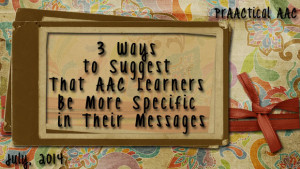
Do you work with AAC learners who seem perfectly content saying things that are vague or non-specific, despite their ability to communicate more precisely? It puts a burden on the partner to use context to figure out the meaning, and sometimes this is efficient and quite necessary. Other times, however, it makes sense to seize the opportunity to teach them about saying things that are clear enough to be understood without relying on context or the partner’s knowledge of the AAC user. Like you, we sometimes work with people who are learning to be more specific in the things that they say. For those learners, we try to balance enthusiasm and interest in the message with cues that direct them to add more information. We’ve noticed that some AAC practitioners are reluctant to press the learner to communicate in more specific terms, and we certainly agree that there are times when the... [Read More...]
Filed under: PrAACtical Thinking
Tagged With: clarity, language intervention, language therapy, specificity
June 30, 2014
by Carole Zangari -
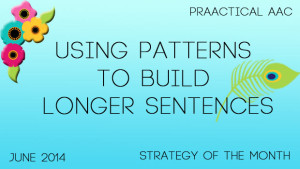
Throughout the month, we’ve been talking about building sentence length and complexity. We’ll end the month with a concept that applies to both beginning communicators and those with more complex language skills. Human beings are pattern-seekers. We notice similarities and distinctions, and compare things that are new to us to things we already know about. As we go through our lives, we draw on our pattern-seeking skills to learn about and understand the world. How can we use this intrinsic trait to help us in teaching language to AAC learners? Consider patterns when choosing your targets: Increasing sentence length is a broad goal that gives us lots of flexibility in how we design our intervention. We can lengthen sentences by adding descriptors, temporal terms, conjunctions, embedded clauses, and more. Within each category, there are many options. For a beginning communicator, we might teach descriptors related to appearance (e.g., size, color,... [Read More...]
Filed under: Strategy of the Month
Tagged With: language intervention, sentence length, sentence structures
June 16, 2014
by Carole Zangari -

Expanding the length and complexity of sentences is something that SLPs love to work on well beyond the ‘early communicator’ phase, something we talked about a few weeks back. In today’s post, we’ll consider ways to build more complex utterances for learners who are gaining competence with their AAC systems but who still use language that is immature, imprecise, or overly simplistic. In many ways, this therapy is like language therapy for any other learner with delays in grammar, syntax, and morphology. Indeed, we sometimes forget to activate all that we know about language intervention when working learners who use AAC. We try to use that as a starting point and adjust for the AAC components as needed. Here are some of the things that we think about when planning therapy for AAC learners who are trying to strengthen their ability to speak in more complex sentences. Relate the language... [Read More...]
Filed under: Strategy of the Month
Tagged With: intervention, language intervention, sentence length, strategy
April 3, 2014
by Carole Zangari -
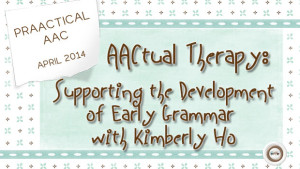
Our guest post for today is from SLP Kimberly Ho, an AAC specialist who operates a private practice, AAC Services. I met Dr. Ho many years ago when she was getting her master’s degree at Purdue University. She went on to get her doctorate and now consults for a number of public schools and works with individuals with AAC needs from preschoolers to adults. Kimberly is active in teaching (undergraduate and graduate courses), writing (published three articles in peer reviewed journals) and public speaking (15 presentations at regional, national and international conferences). In this post, she discusses some concepts in teaching grammar to people who are learning AAC. Traditionally, individuals with complex communication needs (CCN) were provided with communication boards or speech generating devices (SGDs) filled with topic specific vocabulary often called fringe words. The field of AAC is only just beginning to provide early communicators with access to Core... [Read More...]
Filed under: PrAACtical Thinking
Tagged With: Brown's stages, grammar, Kimberly Ho, language intervention
February 2, 2013
by Carole Zangari -

Although it has been close to 25 years since Dr. Janice Light’s hallmark paper on communicative competence in AAC discussed four main purposes of communication, many AAC systems are still heavily populated with messages for basic wants and needs. The other areas – information transfer, social closeness, social etiquette – are often underrepresented in AAC systems. We scratched the surface of how to teach basic requesting last month, and now we’re ready to talk about communicating for other reasons. In this post, we’ll talk about some of the clinical issues in teaching communication for the purpose of information transfer. A big reason that we express ourselves is to share information that others want or need. It may not seem like a high priority until we realize how often we need to do this to function in our daily lives. Here are some examples, both positive and negative, from our work... [Read More...]
Filed under: Strategy of the Month
Tagged With: AAC goals, communicative competence, information transfer, language intervention, strategy
January 5, 2013
by Carole Zangari -
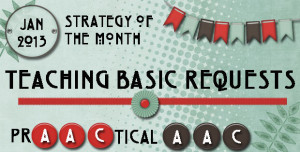
With the start of the new year, we thought it would be a good time to get back to basics. So this month, we’ll talk about the nitty gritty of teaching basic requesting to someone who is first learning to communicate using AAC. For learners who are not sending purposeful communication signals or those who seem unaware that communication involves interaction with another person, we think it makes sense to consider using the PECS curriculum. Why? Because the act of being assisted in physically giving a picture symbol to another person in exchange for a desired object can be an efficient way for someone to gain awareness of two critical principles. First, they learn that communication gives them the power to impact their environment. Secondly, the direct exchange highlights the fact that communication involves two people. As the PECS curriculum is already well established, its procedures will not be addressed... [Read More...]
Filed under: Strategy of the Month
Tagged With: Instruction, language intervention, requesting, teaching
November 19, 2012
by Carole Zangari -
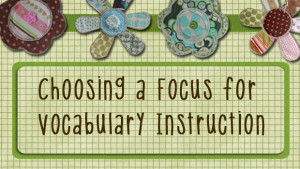
In writing our posts on vocabulary teaching, we came across a host of vocabulary materials, games, apps, activities, lesson plans, worksheets, and websites. Some were by SLPs, but the majority were by general education teachers, teachers of English as a second language, and special education teachers. No matter what the age, grade level, or instructional setting, they all shared the same focus: teaching the meaning of new words. At first glance, that makes sense. But learning the meaning of new words is just the beginning. There are other, equally important things to focus on in vocabulary instruction that go beyond learning the meaning of new vocabulary words. Beyond learning the meaning of brand new words (“I understand it when I hear it.”), we can help learners to: • Develop a deeper understanding of known words (“I understand different aspects of this word.” “I know many different ways to use this... [Read More...]
Filed under: PrAACtical Thinking
Tagged With: broader lexicon, intervention, language intervention, lexical diversity, new word learning, semantics, vocabulary
July 29, 2012
by Carole Zangari -
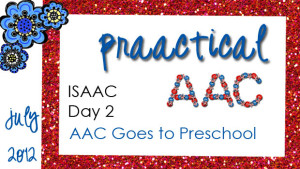
It was another wonderful day here in Pittsburgh at the 15th Biennial ISAAC Conference. It was a special day for me because I had the opportunity to speak about a really fun topic, core vocabulary teaching for young children with AAC needs. It was certainly a group effort! A talented graduate student of ours, Tathiane Paiva, and I shared a framework for developing a curriculum to teach core language in preschool classrooms, and used the curriculum I developed with Lori Wise (special educator and literacy specialist with UM NSU CARD) as an example. The basic principles behind the approach we shared are listed below. – •Language and literacy learning happen all day long. •Children learning AAC need high-quality instruction to learn and use basic vocabulary. •Children learning AAC need frequent opportunities for learning and practice. They need dozens of carefully planned opportunities to use their new words each day. •The focus is on... [Read More...]
Filed under: PrAACtical Thinking
Tagged With: Conference, curriculum, ISAAC, ISAAC 2012, language intervention, preschool, presentation, schools









